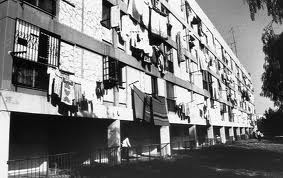On May 22, 2015, at the Dodson Conference Centre, in Vancouver, we convened leaders in public housing including policy-makers, politicians, the private and non-profit sector, tenants, academics and activists for an afternoon of dialogue and practical discussion. UBC School of Community and Regional Planning adjunct professor, Aftab Erfran, used a collaborative transformative scenario planning approach, adapted from a process used in post-apartheid South Africa, to respond to the following situation:
We’re facing seemingly intractable housing challenges in the Lower Mainland. At times it seems there is little hope for maintaining, let alone enhancing public housing in our region. But if we drop the dominant narratives of a likely bleak future, what can we imagine in the space of possibilities for public, social and co-op housing? Are some paths into the future more desirable than others, and if so how can we influence decision-makers to steer into these desirable directions?
Graduate students from her class on Negotiation and Facilitation, facilitated the process. We had the unique opportunity of being joined by international housing experts who helped put regional public housing trends and issues into a global perspective, giving us new ideas and strategies for moving forward.
Please read through the 4 scenarios that emerged from this process, and vote on the future that you want to see for housing!
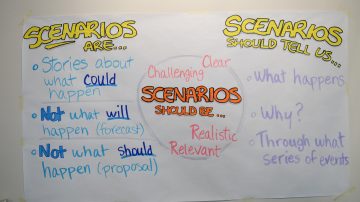
SCENARIO 1: It’s a Wonderful Life
Low government engagement and high civic action
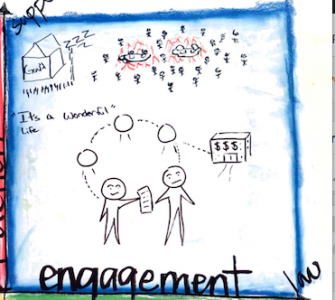
The story starts with an affordability crisis: the federal government says there is no more money in the budget for housing. The response is an increase in partnerships between the private and non-profit sectors. However, after a short time these partnerships start to fall apart, and society calls on government to act. The government still refuses support, and non-profits experience burn-out and low morale. Then civil society takes housing into it’s own hands, developing informal settlements and building it’s own communities. This is followed by a rise in civil lending institutions (in the form of VanCity): SurCity, RichCity, WestvanCity, etc. But the crisis is not really going away. Private sector gets involved – there is a reemergence of the company town: corporations build housing for employees. Yet, people still turn to informal settlements. Eventually a riot breaks out. There is occupation of offices, vandalism, and a huge fire breaks out. This gets the attention of the federal and provincial governments, who are finally forced to address the housing crisis and a federal election is called.
SCENARIO 2: Lord of the Flies
Low government engagement and low civic action
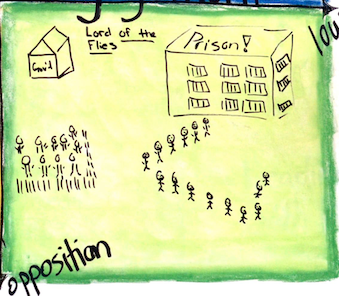
People have no faith in the housing situation and start to turn on each other; groups go off on their own paths. Those who have housing cling to what they have and become very isolated. Gated communities arise, and people no longer engage with each other. The situation gets considerably worse for those with no housing, and informal settlements rise up in response. The government is in a lot of trouble: there is a greater strain on resources than ever due to increasing demand for prisons, health care, etc. stemming from the housing problem. The situation only worsens because the government still provides no support. People start moving away, and the economy starts to collapse. There are small glimpses of hope: people on the fringes get resourceful. But there is no end, the housing crisis is terrible cycle filled with individualism and everyone clinging to what they have.
SCENARIO 3: The Many Legged Octopus in a Sea of Change
High government engagement and high civic opposition
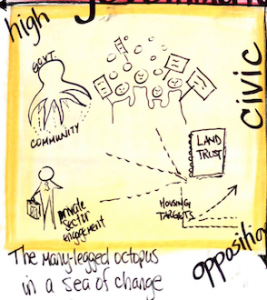
The government is in the habit of doing whatever developers want. Communities push for change and activism increases. This forces the government to become more involved in housing issues, and also results in a community land trust. Housing is now in the community’s control: they have their own targets for housing units, and development is negotiated based on an open dialogue between communities.
SCENARIO 4: Complete Just Communities
High government and high civic engagement
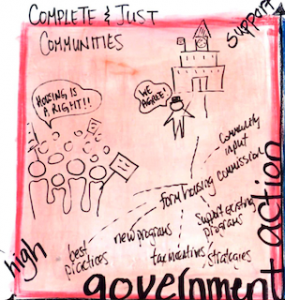
Society rallies and protests to try to attain government support for public housing. Communities start to come together, and residents articulate that housing is a need and a right. Government acknowledges this, and develops a mandate to increase public housing. There is a year-long plan to create the necessary changes. New programs are funded and there is increasing support for current ones. Co-ops are supported, the minimum wage is raised, monitored public/private partnerships develop, and the government provides tax incentives to affordable housing developments. Time and resources are invested in identifying best practices for partnerships between government and non-profits. The results of government policies and support are: mixed neighbourhoods, healthy communities, housing choices, clean and safe SROs, mental health supports, reduced red tape to accessing housing and support, and no dead-zones. Additionally, there are side-effects such as better access to education, and a vibrant economy because people now have disposable income. The final result is that there is no longer any waitlists for public housing.



